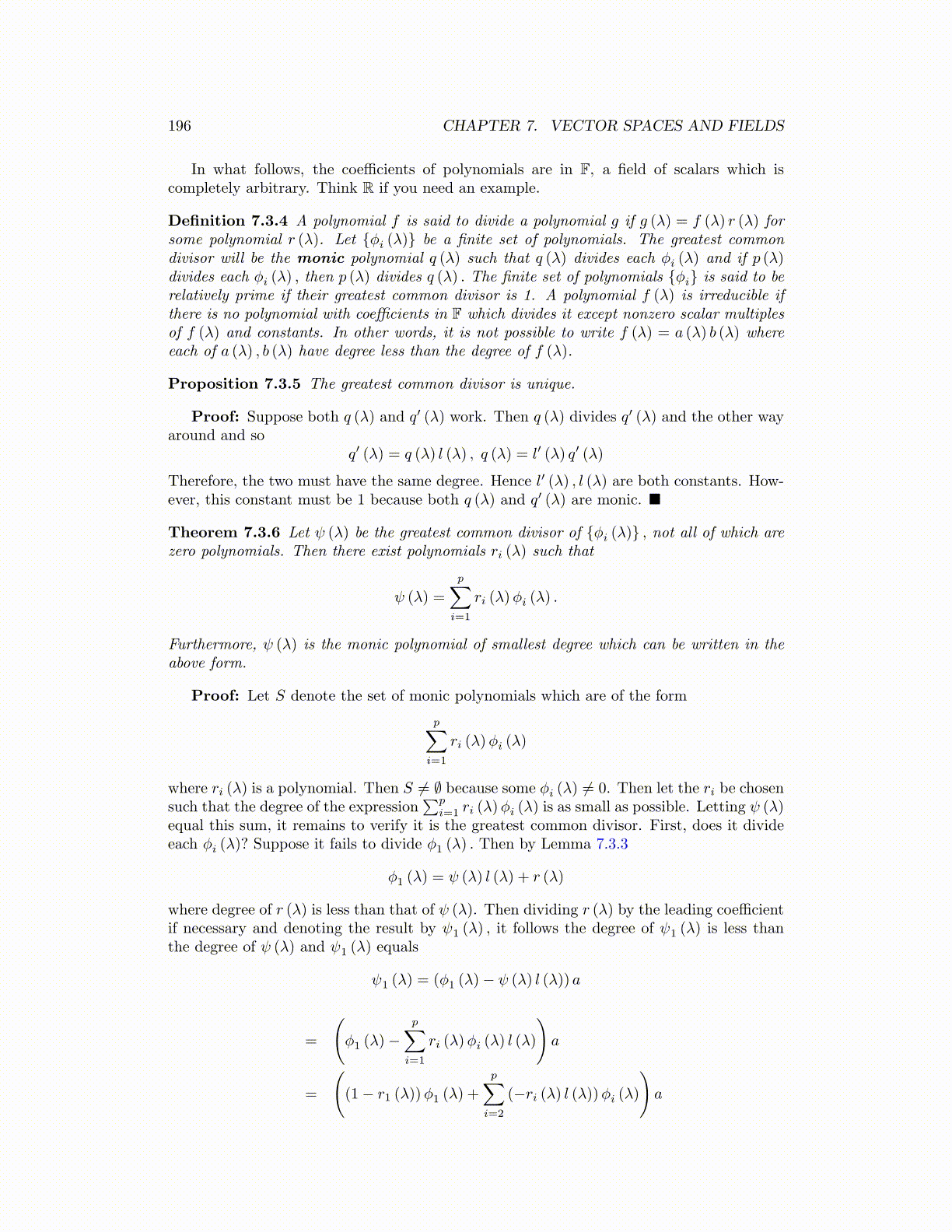
196 CHAPTER 7. VECTOR SPACES AND FIELDS
In what follows, the coefficients of polynomials are in F, a field of scalars which iscompletely arbitrary. Think R if you need an example.
Definition 7.3.4 A polynomial f is said to divide a polynomial g if g (λ) = f (λ) r (λ) forsome polynomial r (λ). Let {ϕi (λ)} be a finite set of polynomials. The greatest commondivisor will be the monic polynomial q (λ) such that q (λ) divides each ϕi (λ) and if p (λ)divides each ϕi (λ) , then p (λ) divides q (λ) . The finite set of polynomials {ϕi} is said to berelatively prime if their greatest common divisor is 1. A polynomial f (λ) is irreducible ifthere is no polynomial with coefficients in F which divides it except nonzero scalar multiplesof f (λ) and constants. In other words, it is not possible to write f (λ) = a (λ) b (λ) whereeach of a (λ) , b (λ) have degree less than the degree of f (λ).
Proposition 7.3.5 The greatest common divisor is unique.
Proof: Suppose both q (λ) and q′ (λ) work. Then q (λ) divides q′ (λ) and the other wayaround and so
q′ (λ) = q (λ) l (λ) , q (λ) = l′ (λ) q′ (λ)
Therefore, the two must have the same degree. Hence l′ (λ) , l (λ) are both constants. How-ever, this constant must be 1 because both q (λ) and q′ (λ) are monic. ■
Theorem 7.3.6 Let ψ (λ) be the greatest common divisor of {ϕi (λ)} , not all of which arezero polynomials. Then there exist polynomials ri (λ) such that
ψ (λ) =
p∑i=1
ri (λ)ϕi (λ) .
Furthermore, ψ (λ) is the monic polynomial of smallest degree which can be written in theabove form.
Proof: Let S denote the set of monic polynomials which are of the form
p∑i=1
ri (λ)ϕi (λ)
where ri (λ) is a polynomial. Then S ̸= ∅ because some ϕi (λ) ̸= 0. Then let the ri be chosensuch that the degree of the expression
∑pi=1 ri (λ)ϕi (λ) is as small as possible. Letting ψ (λ)
equal this sum, it remains to verify it is the greatest common divisor. First, does it divideeach ϕi (λ)? Suppose it fails to divide ϕ1 (λ) . Then by Lemma 7.3.3
ϕ1 (λ) = ψ (λ) l (λ) + r (λ)
where degree of r (λ) is less than that of ψ (λ). Then dividing r (λ) by the leading coefficientif necessary and denoting the result by ψ1 (λ) , it follows the degree of ψ1 (λ) is less thanthe degree of ψ (λ) and ψ1 (λ) equals
ψ1 (λ) = (ϕ1 (λ)− ψ (λ) l (λ)) a
=
(ϕ1 (λ)−
p∑i=1
ri (λ)ϕi (λ) l (λ)
)a
=
((1− r1 (λ))ϕ1 (λ) +
p∑i=2
(−ri (λ) l (λ))ϕi (λ)
)a